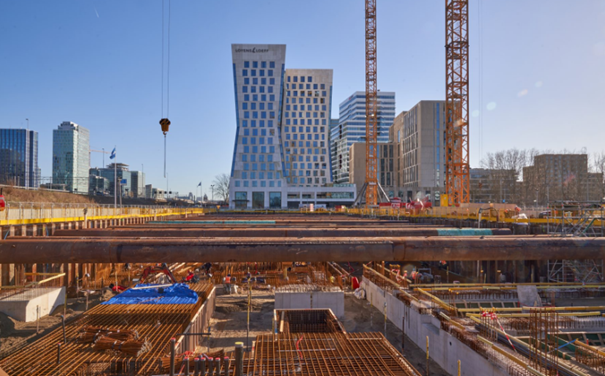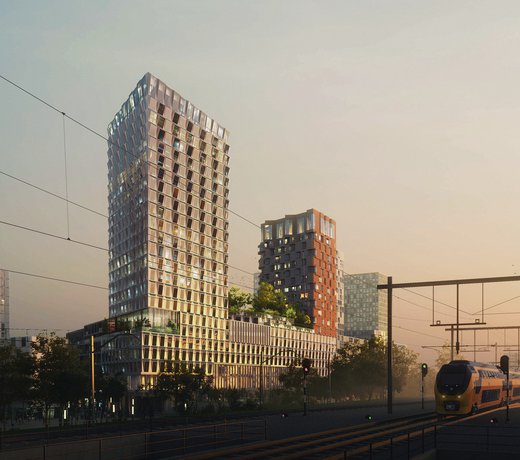Apart from the three formidable-looking cranes – the tallest reaches some 85 meters into the air – there is little above ground that hints at the construction of The Pulse of Amsterdam. From the A10 you can catch a glimpse of some twenty huge pipes between the sheet piles, but the view does not extend much further. Nevertheless, Vorm Bouw is working hard at a depth of six meters on perhaps the most important part of the new, multifunctional building in the Kenniskwartier: the foundation. We take a look with Arie van Zessen, foreman of VORM Bouw.
Braiding
As soon as we descend to the so-called construction pit, one thing immediately catches the eye. Almost the entire bottom is covered with a kind of grids of steel wire. It is reinforcement steel, explains Van Zessen. In some places it rises in an ingenious way and a kind of cubes arise. "As you can see, we are busy with the wickerwork," says Van Zessen, pointing to one of those cubes. The analogy is clearly visible: just like you make a braid of hair, the steel wires are intertwined to form a kind of skeleton. ‘We then apply formwork around it, a kind of mould. We pour concrete into it, creating massive blocks. We call them powders. The wickerwork forms the reinforcement for the bases, which support the construction.'
Vibrant and sustainable
The Pulse of Amsterdam should become a real eye-catcher in Zuidas. The two different towers of about 80 and 90 meters high will be connected via a lower building section, with a city forest on top. The Pulse will be part of a cluster of buildings surrounding a lush, public courtyard. There will be two hundred apartments in the complex: 151 in the middle segment and 49 private sector homes. Add to that 36,000 meters of office space, and facilities such as a cinema, catering industry and a supermarket. Developers VORM and EDGE want to make The Pulse a lively part of the Knowledge Quarter in this way. Sustainability is a top priority: the building will be completely self-sufficient and energy neutral.
Seven hundred tons of rebar
When we walk again above the construction pit, Van Zessen points to a large pile of long rods. ‘They form part of the reinforcement for the wickerwork of the base under the office tower,’ he explains. A number of bases – in particular those in front of the residential tower – are already standing, but one large base is being made under the office tower, as it were. “That has to do with the construction structure. You need a different carrying capacity for this part of the building', says Van Zessen. “We need seven hundred tons of rebar for that one piece. That's 23 trucks full, to be exact. Have you tried lifting a bar like that?” He laughs briefly. "Heavyweight, huh? That's what we use the cranes for. You don't just lift them into the cockpit yourself.'
Phases of foundation
Work on The Pulse has already started in August 2021 with the installation of the sheet piles for the cofferdam. ‘A bit cliché, but the foundation is essential,’ explains Van Zessen. He patiently lists the different phases in the process. “Before you can dig, you first have to pump out the groundwater.” He shows a white pipe leading up from the cofferdam towards a pump. The water that the pipe drains is pumped back into the ground a little further on. 'By the way, the water draining continues continuously', says Van Zessen, 'otherwise you can do the front crawl here within ten minutes.'
Combi piles
After the sheet piles have been installed, pile driving, or the installation of the piles, follows. Use was made of so-called combi-piles, a system in which piles go into the ground with low noise and vibration-free. How it works? Van Zessen: 'You drill a steel tubular pile into the ground, which forms the shaft, as it were. You put a prefab concrete pile in it, which you fill with concrete. Then you unscrew the steel tubular pile again.' After the pile-driving, the excavation and pouring of the work floor follows. Then comes the armament. 'You need that work floor, because otherwise the reinforcement for the bases will sink into the sand,' explains Van Zessen.
Schedule
It is expected that the work on the foundation will be completed in early April 2022, after which a start will be made on the basement walls. The delivery of The Pulse of Amsterdam is planned for the end of 2024.
Header and picture by Marcel Steinbach

